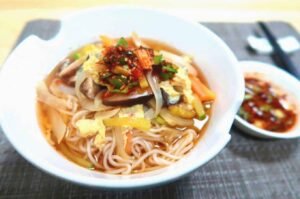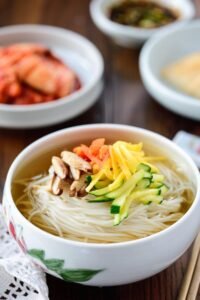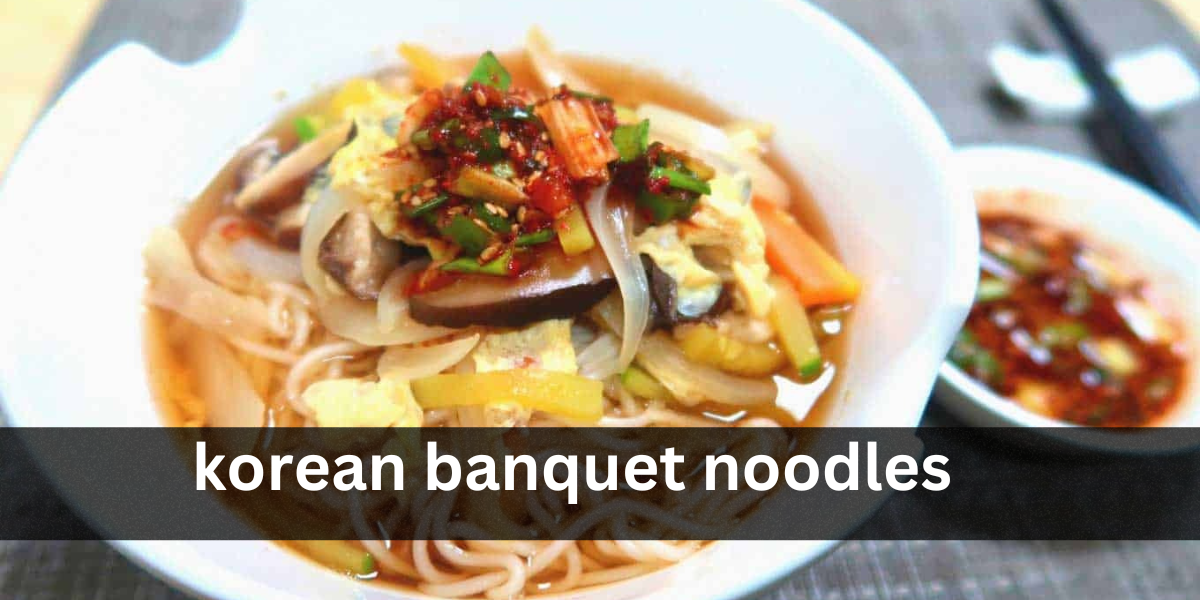The Korean banquet noodles are one of the many varieties of noodles that I enjoy eating the best out of all of them. You have a wide variety of options available to you when it comes to purchasing noodles. These two names are used to refer to it in the same context. When it comes to describing a gathering of people, the word “party” or “banquet” is a direct translation from the Japanese word “janchi” into the English language. This is the consequence of taking into consideration the fact that the word “guksu” originates from the Japanese language and means “noodles.” The outcome is “party noodles,” which is the result of this consideration.
Traditionally, these noodles were served during weddings and other family meetings in Korea, such as hwangap, which is a celebration of a person’s 60th birthday. Other family gatherings in Korea included hwangap. In addition to that, they were well-liked at several other family gatherings. Furthermore, these noodles were a component of another family celebration event that took place. When various sorts of family gatherings were celebrated in Korea in the past, these noodles were frequently devoured as part of the festivities. In addition, they were a traditional feature of the celebrations. In the present moment, the noodles are not only easily accessible, but they can also be found in Seoul with a considerable deal of ease. This provides a significant advantage. Getting your hands on them is not a tough task.

It is necessary to make use of wheat flour during the preparation procedure in order to achieve the objective of manufacturing noodles. After that process has been finished, the noodles are brought to a boil in a broth that is fairly delicate. After that step is over, the noodles simmer. The majority of the time, a stock made from anchovies is used in the preparation of Korean noodles. The majority of the preparations are built upon this stock, which serves as the foundation. On the other hand, in the context of this particular cuisine, a foundation made up of pure soy sauce is utilized instead of any additional ingredient. If you want to get a sense of how well it works, it is recommended that you test it out at home with a few other people; this will give you the best possible experience. It is recommended that you take a few sips of the mild broth before beginning to consume this noodle.
noodles
This will make it possible for you to get the most out of the noodle and will ensure that you get the most out of it from the beginning. When you do this, you will be able to extract the most benefit from the bean sprouts. By utilizing this strategy, you will be able to obtain a taste of the flavor of the soup before you add the topping sauce. This will allow you to make an informed decision. Having this information at your disposal will make it easier for you to make an informed decision. After you have finished eating the noodles, you should take another mouthful of them, and then you should carefully combine the topping sauce with the noodles.
This should be done as soon as possible. Continue to operate in this manner until the process is finished. At all times, it is of the utmost importance that you keep a careful check on the progress that the broth is making. Personally, I like to incorporate a small amount of the topping sauce into each bite that I consume. This is my preferred method. This is the choice that I ultimately decide to make for myself. This enables me to experience a sense of fulfillment on a personal level.
Ingredients
Noodles & Broth

- Thin wheat noodles – 200 grams Somyeon Noodles
- Water – 4 cups
- Zucchini – ½ a whole
- Onion – ½ a whole
- Carrot – ¼ a whole
- Shiitake mushrooms – 3
- Eggs – 2
- Soy sauce – 2 Tablespoons
- Soup soy sauce – 2 Tablespoons
- Salt – ½ teaspoon
Topping Sauce
- Scallions – 4 stalks
- Cheongyang chili peppers – 1.5 peppers
- Water – 2 Tablespoons
- Soup soy sauce – 2 Tablespoons
- Soy sauce – 2 Tablespoons
- Gochugaru Korean red chili flakes – 1 Tablespoon
- Sesame seeds – 1 Tablespoon
- Sesame oil – 1 Tablespoon
- Minced garlic – 1 teaspoon
- Sugar – ½ teaspoon
Instructions
Make Topping Sauce
-
Cut the scallions into 1 cm pieces and slice the Cheongyang chili peppers into small pieces.
-
Place scallions and peppers into large mixing bowl. Then add minced garlic, red chili flakes, sugar, sesame seeds into bowl – give it a thorough mix. Then add soy sauce, soup soy sauce, water and sesame oil. Give a good mix.
Cook Noodles
-
Place water into a pot and bring it up to a boil. Once it is boiling, place in the thin wheat noodles.
-
Foam will begin to rise to the top – put a dash of cold water into the pot to bring the foam back down. Repeat this process about 5x and the noodles should be fully cooked through.
-
Pour out noodles into a sieve and place them under cold running water to stop the cooking process. Wash the noodles thoroughly and then squeeze out the excess water. Set aside and move onto broth.
Cooking Broth
-
Slice the onion, zucchini, carrot and mushrooms into long strips (julienne cuts).
-
Pull out a large pot and pour in water (4 cups), soy sauce (2 Tablespoons) and soup soy sauce (2 Tablespoons). Bring the pot up to a boil and add salt. Then pour in all of the vegetables and wait until the pot comes back up to a boil.
-
Let the vegetables boil for 1 minute (they should then be soft and fully cooked). After one minute, pour eggs in a circular motion into the soup (optional step). Turn off heat and you are ready to serve.
-
To serve, put a handful of the noodles into a bowl and pour soup on top of the noodles. Place a spoonful of topping sauce on top.
FAQs:
Can I use other types of noodles for janchi guksu?
You can choose to use a variety of noodles, such as somyeon, which is produced from thin wheat; soba, which is created from buckwheat; or even rice noodles if you so wish. All of these options are available to you. In spite of the fact that the traditional dish is prepared with noodles made from thin wheat flour, you are free to use any kind of noodles you see appropriate.
Can I make the broth in advance?
It is possible to prepare the broth in advance and then keep it in the refrigerator for up to three to four days until it is necessary. There is a chance that this will occur. Immediately prior to serving, bring the broth back up to temperature and, if necessary, make any necessary adjustments to the seasoning that may be required.
Can I make janchi guksu vegetarian or vegan?
Yes, you can make a vegetarian or vegan version of janchi guksu by using vegetable broth instead of meat-based broth and omitting meat toppings. Add more vegetables or tofu for protein and flavor.
What other side dishes can I serve with janchi guksu?
Janchi guksu can be made suitable for vegetarians and vegans by substituting vegetable broth for animal-based broth and removing the toppings that include meat. It would be beneficial to make the dish more accessible to individuals who do not consume meat if it were prepared in this manner. There will be an increase in the amount of protein as well as an improvement in the flavor of the dish if you add more veggies or tofu.
How do I eat janchi guksu?
A variety of banchan, which are meals that are supplied as side dishes, are frequently served alongside janchi guksu. This is done in order to enrich the whole experience of the meal. Jeon, which are primarily Korean pancakes, and kimchi, which are comprised of veggies that have been pickled, are both examples of banchan.
Can I store leftover janchi guksu?
If you put any leftover janchi guksu in an airtight container, you can keep it in the refrigerator for one to two days. This amount of time is sufficient for preservation. The amount of time that can be permitted is limited to this maximum quantity. You can reheat it before serving it by either doing it on the stovetop or in the microwave using a setting that achieves a low temperature. Both of these options are available to you.
ALSO READ: korean hansik meal
